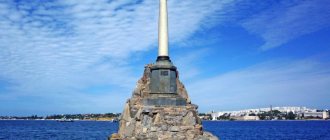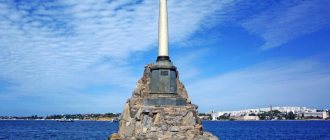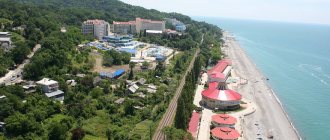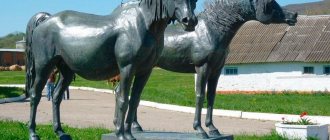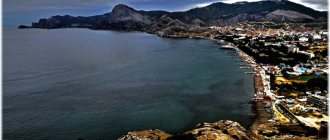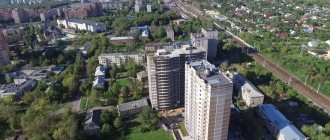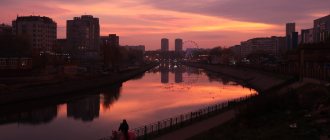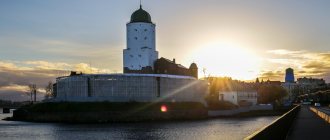This beautiful city, located on the shores of a picturesque bay of the Heracles Peninsula, is rightfully considered the tourist Mecca of Crimea. People come here to combine relaxation on the magnificent Black Sea beaches with exploring the unique sights of Sevastopol. It more than once justified the proud name given by Catherine the Great, standing in the way of the hordes of foreign invaders who tried to deprive Russia of its dominance in the Black Sea as an insurmountable barrier, survived many sieges, was destroyed and rebuilt again. The most important milestones in the history of the Hero City are reflected in numerous monuments.
The main attractions of the city of Sevastopol - TOP-5
The history of the wonderful city, founded in 1783, is not too long, but extremely eventful, many of which became significant for Russia. The sights of Sevastopol, photos and descriptions of which you will find below, are its main symbols. It is important that you can see them in 1 day.
Monument to the Scuttled Ships
- Address: Opposite Primorsky Boulevard, 23 meters from the embankment.
The history of the city is inextricably linked with the history of the Russian Black Sea Fleet, one of the most tragic pages of which is dedicated to the monument depicted on the coat of arms of Sevastopol. In the fall of 1854, a powerful Anglo-French-Turkish squadron with an army of almost 150 thousand on board was preparing to enter the bay and land troops. The Russian sailing fleet could not resist the Allied steam ships at sea.
The illustrious Admiral Nakhimov was forced to make an extremely difficult decision to scuttle warships at the entrance to the bay. For the 50th anniversary of this event, a 16.7 m high monument appeared on an artificial rock opposite Primorsky Boulevard. A 7-meter dolomite column is installed on an octagonal pedestal, the capital of which is crowned with a bronze double-headed eagle holding a laurel wreath and an anchor in its beaks.
Count's pier
- Address: Nakhimov Square, 4. Transport stop “Nakhimov Square”.
Modern Sevastopol began, in fact, with a fortress and a pier for warships, built in 1783. It was on the site of the latter in the second third of the 19th century. It was decided to erect an architectural structure, which later became the main naval gate of the city.
A magnificent staircase of four wide flights, framed by stone parapets, decorated with beautiful sculptures of lions, leads to the elegant double colonnade from the pier. Commemorative plaques on the walls of the pier tell about significant events in the history of the Black Sea Fleet.
Chersonese Tauride
- Opening hours: daily, from 9:00 to 17:00.
- Ticket price: from 100 rub. up to 300 rub.
- Phone: +7 869 292‑23-82.
- Website: https://www.chersonesos-sev.ru
- Address: st. Ancient, 1. Transport stop "Tavrichesky Chersonesus".
Having made a three-kilometer journey from the center of Sevastopol, you will find yourself among the ruins of the ancient city of Chersonesos, founded by Greek colonists in the 5th century. BC e., which existed for almost 2 thousand years and was destroyed by steppe nomads.
During the excursion, tourists will see the ruins of once magnificent temples, an amphitheater, houses of citizens and other buildings. The archaeologist was able to partially restore several remarkable colonnades. Be sure to visit the Fog Bell, located near the Agora. It is cast from cannons taken from captured Turkish ships in 1778.
Primorsky Boulevard
- Address: Embankment in the Sevastopol Bay area. Transport stop "Nakhimov Square".
The magnificent boulevard, which is now a favorite vacation spot for citizens and numerous guests of the city, appeared on the site of the Nikolskaya battery destroyed during the Crimean War in 1855. Then a wonderful pavement was laid here, along which many trees and shrubs were planted, and a little later magnificent flower beds appeared.
After some time, recreation was replenished with the building of a theater and a biological station. In the evenings you could hear the music of the naval orchestra on the boulevard. For a long time, entry here was closed to sailors and lower naval ranks. There are several historical and architectural monuments in the boulevard area.
Malakhov Kurgan
- Address: st. Heroes of Sevastopol. Transport stop "Malakhov Kurgan".
The name of the hill on the Korabelnaya side of the city is inscribed in golden letters in the chronicle of Russian military glory. Possession of the mound made it possible to gain strategic superiority, which provided the keys to the capture of Sevastopol. Therefore, it was here that the bloodiest battles took place during the First and Second Defense of the city.
During the excursion, tourists visit the defensive tower, in front of which the Eternal Flame burns, the location of the batteries that defended the city in the Crimean and Great Patriotic Wars. As before, artillery pieces are installed here. Be sure to stroll through the magnificent park and admire the panoramic views from the observation decks.
What excursions are worth visiting?
Walk around the city with a guide
A walking tour offers city guests to get to know Sevastopol from an unusual side : stroll through the streets, squares and hills, see the sunset over Sevastopol Bay and learn interesting facts about the emergence and important events of the city. The starting point of the tour is Nakhimov Square.
Cost – 3490 ₽ for a group of up to 10 people, regardless of the number of participants.
Walking tour
A 3-hour walking tour for groups of up to 5 people includes an introduction to little-known sights for tourists: Korabelnaya Slobodka, where the city began; Bastions of the Crimean War; Roman aqueduct; places where the writer A. Green and others loved to visit. A mandatory point of the program is a visit to the Malakhov Kurgan and several observation platforms .
- Cost – 2000 ₽, regardless of the number of participants.
Individual tour
This walking tour is dedicated to the events of the Crimean and Great Patriotic Wars . In 2.5 hours, excursionists will have to walk along the Historical Boulevard, visit Panorama I of the Defense of Sevastopol; see the places where battles took place during the Second World War and visit the Memorial to Soviet Soldiers; get acquainted with the key attractions of the city dedicated to the events of the war years.
- Cost – 2600 ₽ for groups of up to 10 people , regardless of the number of participants. Additional expenses: visit to Panorama, optional boat trip.
What attraction is a must-see while vacationing in Sevastopol? We believe that this is the Chersonesos nature reserve ! It represents the ruins of an ancient ancient city, with interesting museums on the territory and beautiful views of the sea. The cost of excursions is from 350 ₽ for adult visitors, from 175 ₽ for children over 7 years old. A visit to the antique exposition - 150 ₽/75 ₽, to the Byzantine exposition - 150 ₽/75 ₽.
Magnificent architecture of Sevastopol
The city has many places of great interest to tourists. Walking along its streets and boulevards you can see magnificent historical and architectural monuments, against which it is easy to take wonderful memorable photographs.
Black Sea Fleet Theater building
- Address: Ushakov Square, 1. Transport stop “Ushakov Square”.
Sevastopol acquired one of the most colorful architectural landmarks in 1954. Then there was a need to build a new building for the Sailors' Club, where sailors could have a cultural rest in between trips. As a result, an elegant structure appeared on Ushakov Square, more like a palace.
The three-story building has a bar terrace with a delightful colonnade. The elegant six-story tower, topped by a long spire, houses four large dials. Every time their hands count down the next hour, a refrain from the song “Legendary Sevastopol,” considered the anthem of the city, sounds over the square.
Monument to P.S. Nakhimov
- Address: Nakhimov Square. Transport stop "Nakhimov Square".
Monument to the famous naval commander, a worthy successor to the glorious deeds of the great Russian admirals F.F. Ushakova and M.P. Lazarev, the creators of the Russian Black Sea Fleet, was erected in 1898. At its grand opening, dedicated to the 45th anniversary of the defeat of the Turkish fleet at Sinop, Emperor Nicholas II was personally present. During the years of revolutionary nihilism, the bronze sculpture was removed from its pedestal and melted down.
However, in 1959 the monument was exactly restored. The figure of Pavel Stepanovich, who gave his life for Sevastopol, rises 13.5 m. He is depicted dressed in an admiral's overcoat. In one hand Ushakov holds a telescope, and the second rests on the handle of a broadsword. The granite pedestal is decorated with high reliefs dedicated to the Battle of Sinop and the defense of the city during the Crimean War.
Tower of the Winds
- Address: st. Frunze, 5. Transport stop “Lazarev Square”.
The unique architectural structure, built towards the end of the 19th century, was intended to serve quite prosaic purposes - to promote air circulation in the premises of the Maritime Library. However, its creators showed extraordinary talent.
An octagonal turret in the antique style with an arched rotunda of the second tier has become one of the architectural highlights of Sevastopol. Ironically, it outlived the building of which it was part of the ventilation system. In 1955, the library was destroyed by fire, but the elegant structure with luxurious mythological bas-reliefs still adorns the city.
Catherine's Mile
- Address: st. Chelyuskintsev. Transport stop "Internat".
As you know, His Serene Highness Prince G.A. Potemkin was distinguished by his sophistication of mind and was ready to do anything to earn the favor of the empress. Therefore, for Catherine II’s trip to Crimea, special mileposts were installed along the entire route of the motorcade, and small monuments – miles – were installed every ten miles.
Several unique monuments have survived on the peninsula to this day. The Sevastopol Mile is a small limestone column, taking the shape of a hexagon in the central part and ending in an elegant cone.
Monument to V.A. Kornilov
- Address: Malakhov Kurgan. Transport stop "Malakhov Kurgan".
A monument to another hero of the Crimean War - Vice Admiral V.A. Kornilov, who led the First Defense of Sevastopol until his last breath, was opened in 1895. The Great Patriotic War did not spare the monument, but it was restored for the 200th anniversary of the city in 1983 based on a model preserved in the archives of the Maritime Museum of St. Petersburg.
On a diorite plinth there is a pedestal depicting a fragment of a fortress wall pierced by cannonballs. A sculpture of the already mortally wounded Kornilov is placed on it. The Vice Admiral rises with difficulty on his arm and takes a last look at the sailors and soldiers defending the city. To the left of the pedestal is depicted sailor Pyotr Koshka loading a gun.
Chorgunsky bridge-aqueduct
- Address: Chernaya River.
The now abandoned water bridge across the Black River near Sevastopol, due to its main function, is called an “aqueduct”, in the ancient Roman manner. It was erected in the middle of the 19th century. The initiator of the construction was Admiral Lazarev, so the aqueduct also has a second name - Lazarevsky. The construction of the bridge ended in 1853, when the Crimean War began, an important stage of which was the defense of the city.
Chersonesos lighthouse
- Address: Cape Khersones.
At the westernmost point of Sevastopol, on Cape Chersonesos, there is a lighthouse that still performs its main function. It is already more than 200 years old. It was built in 1816. It is noteworthy that at the same time, another identical lighthouse appeared on the peninsula - Tarkhankutsky. In design and appearance they are twin brothers.
At night, the lighthouse is illuminated. The Chersonesos lighthouse is notable as the site of the last battles during the defense of the city during the Great Patriotic War. Rumor has it that his “patron” is Nicholas the Wonderworker; during the battles for the city, the face of the saint allegedly “appeared above the lighthouse.” Of course, this is nothing more than a legend.
Monasteries
In the vicinity of Sevastopol there are several Orthodox shrines with a centuries-old history. Monasteries in the vicinity of Sevastopol are something that is worth seeing even for non-Orthodox people. Of tourist interest are cave temples with mysterious grottoes and panoramic views of the surrounding area. The holy monasteries are located within the tourist routes - they can easily be included in a tour of the outskirts of Sevastopol.
Cave monastery of St. Clement in Inkerman
The Inkerman Cave Monastery is one of the oldest Crimean monasteries located in caves. The exact date of foundation has not yet been determined: historians call time intervals from the 8th–9th to the 14th–15th centuries. The monastery is named after St. Clement - according to legend, near the monastery there was a spring that was discovered by the saint. The monastery fell into disrepair after being captured by the Turks in 1475. The monastery was revived only in 1850. In Soviet times, the monastery was closed again; during the Great Patriotic War, the caves were used as a strategic site. The temples were restored in the 90s. Services began in 2022.
The path to the monastery lies through a tunnel. The monastery includes: a fraternal building, outbuildings, a monastery cemetery and 5 active churches. Of these, three churches are still located in caves: those named after St. Clement, St. Martin the Confessor and St. Apostle Andrew the First-Called. At the observation deck you can also see the ruins of the Kalamita fortress.
Inkerman Cave Monastery Photo: © Margarita Kushnirenko
St. George's Monastery on Cape Fiolent
The Orthodox monastery was founded in 891. According to legend, the monastery was founded by Greek sailors who were caught in a storm at Cape Fiolent. The sailors prayed to Saint George for salvation, and when the storm subsided, they found an icon of St. George the Victorious on the rock. The Greeks founded a monastery with a cave church on the shore. Even during the time of the Crimean Khanate, the monastery named after St. George the Victorious continued to operate. During the Russian Empire, the Greeks left the monastery, not wanting to submit to the Russian Orthodox Church. In the 19th century, the military clergy of the Black Sea Fleet were based here. Dilapidated buildings were replaced with new ones. In the 19th century, the monastery was visited by many eminent personalities: Alexander Pushkin, Russian emperors - from Alexander I to Nicholas II, Ivan Aivazovsky, Anton Chekhov.
The ensemble of the St. George's Monastery is divided into 3 parts: the plateau, the western part of the terrace and the surrounding area. On the plateau there is a bell tower built in the 19th century, a library of a military unit (formerly the Vozdvizhensky Church), monuments to Pushkin and St. Andrew the First-Called. On the western part of the terrace there are: fraternal buildings, the Church of St. George (restored in our time), the cave Church of the Nativity of Christ, a refectory, and the source of St. George. In the surrounding area there is a monastery necropolis, a rock with a staircase and a cross, and a descent to Jasper Beach.
Cross on the island near the St. George Monastery on Cape Fiolent Photo: © Masha Malinovskaya
Shuldan Monastery
The little-known Shuldan cave monastery is located north of the village of Ternovka at an altitude of 540 meters in the rock of the same name. Presumably, the monastery was created in the 13th–14th centuries, but rebuilt at the beginning of the 15th century. The main premises of the monastery date back to this period. After the capture of the peninsula by the Turks, the monastery ceased to function and was abandoned for a long time. Now the holy monastery is being revived. The two-tier monastery includes 2 cave temples and 2 dozen caves.
Panoramic view of the Shuldan cave monastery
Detailed material: Monasteries and temples of Sevastopol
Historical sights of Sevastopol
The wonderful city offers guests an extensive cultural and educational program. Tourists will not have any problems with where to go in Sevastopol to gain vivid impressions and learn a lot of interesting things.
Panorama "Defense of Sevastopol"
- Opening hours: Wednesday and Friday from 10:00 to 20:00, other days of the week from 10:00 to 18:00.
- Ticket price: adult 300 rub., student 200 rub., child 150 rub.
- Telephone.
- Website: https://www.sevmuseum.ru/objects/historical-boulevard/panorama
- Address: Istoricheskiy Boulevard, 1. Transport stop “Ushakov Square”.
Among the many sights of Sevastopol associated with the Crimean War, the most striking aesthetic impression is left by the creation of F.A. Rubo. The famous panorama was opened in 1905 on the hill, where 50 years earlier the defenders of the IV Bastion fought off the attacks of the Anglo-French troops.
The interior walls of an elegant round building with a rotunda on the second tier are occupied by a huge painting, 14 m wide and 115 m long, depicting an episode of the heroic defense of the city on June 6, 1855. The painting amazes with the precision of drawing the smallest details.
Diorama “Storm of Sapun Mountain”
- Opening hours: daily, from 10:00 to 18:00.
- Ticket price: adult 250 rub., student 200 rub., child 150 rub.
- Telephone.
- Website: https://www.sevmuseum.ru/objects/sapun-gora/diorama
- Address: st. 2nd defense. Transport stop "Sapun-Gora".
Another heroic event in the glorious history of Sevastopol - the assault on the well-fortified defensive positions of the Nazis on Sapun Mountain - is dedicated to the world's largest painting of a battle theme. The painting, with an area of 83 m², placed on the wall in a semicircle, is the dominant feature of the diorama.
The space 8 m wide between it and the observation deck is occupied by a subject plan, which is a reconstruction of the battlefield. The impression of the composition is enhanced by lighting effects that imitate smoke from shell explosions.
Konstantinovskaya battery
- Address: Cape Konstantinovsky.
The fortification structure, which has become one of the symbols of Sevastopol, refers to the military history of the region and indicates the strategic importance of the port city. The background to the construction of the battery dates back to the era of the annexation of Crimea to Russia. The first fortification on this site was built under the leadership of A.V. Suvorov by order of Catherine II. It was an earthen battery; a stone one replaced it in 1840. It received its name in honor of Catherine’s grandson, Grand Duke Konstantin Pavlovich Romanov. Today there is a museum and exhibition complex here.
Nakhimov Square
- Address: pl. Nakhimov.
The city of Sevastopol began from here. The first buildings were laid in June 1783, among them the house of F. Mekenzie. The Scottish-born rear admiral supervised the construction of the city and is considered its founder. The Rear Admiral's House is also called the Catherine Palace; the Empress herself visited here in 1787. The square was first called Catherine Square, and at the end of the century before last it was renamed in honor of the famous naval commander Pavel Nakhimov, a hero of the Crimean War who commanded the defense of the city.
35th coastal battery
- Address: Alley of Defenders of the 35th Battery, 7.
The fortification structure, built in 1912, became famous during the Great Patriotic War. The battery played a vital role in the heroic defense of the city in 1941-1942. After the war, the battery, damaged in battle, was not restored. Already in the new millennium, a museum and memorial complex was opened here, focusing on significant events in military history. It has been operating since 2007. Nowadays the “35th Battery” is one of the main military-historical monuments of the city of Sevastopol.
Historical Boulevard
- Address: Historical Boulevard.
In the historical part of the city, on a hill above the South Bay, there is a green area with an area of 28 hectares. The history of the boulevard began back in 1840; during the Crimean War, this place performed an important strategic function.
Nowadays the Historical Boulevard has both memorial and recreational and entertainment significance. On its territory there are monuments and memorial sites dedicated to military history. The most famous of them is the Panorama of the Defense of Sevastopol.
Modern attractions are located next to historical attractions, including the main symbol of most cultural parks - the Ferris Wheel. On the territory of the boulevard there are food points, there is everything for a good family holiday.
30th armored turret battery
- Address: North Side district.
One of the symbols of the 250-day defense of the city during the Great Patriotic War. Consists of 30 artillery towers, ready to take a strike. During the days of defense, the battery fought to the last, until the Nazis captured it on June 26, 1942. This building was luckier than the 35th battery - it was reconstructed after the war. An active military facility is “idle” in peacetime, but at any time it can be used for its intended purpose.
Mikhailovskaya battery
- Address: st. Gromova, 35.
Built under Nicholas I in 1846 in order to strengthen the city’s defenses in preparation for the Crimean War. The battery received its name in honor of Grand Duke Mikhail Nikolaevich, the imperial son. She took part in two defenses of the city during the Crimean and Great Patriotic Wars. Today, thanks to the efforts of a local philanthropist, there is a “Museum of City Fortifications”.
First day
The morning city greets guests with the whistles of steamships, the splash of waves, the cries of seagulls and the trills of trams. A map with attractions on your phone will help you navigate Sevastopol. Traditionally, tourists begin their exploration from the central district of the city, where its main objects are located.
Nakhimov Square
One of the oldest squares of the city, its heart - Nakhimov Square is surrounded by numerous attractions. It was in this place that the Catherine Palace was built in honor of the founder Catherine II (later destroyed). Nakhimov Square, pleasing to the eye with its design, is always crowded and lively. All major celebrations take place there: parades, demonstrations, various festivals and concerts. This is a favorite place for recreation and walks for the townspeople.
The spreading crowns of the surrounding trees shade the space. A memorial sign in the form of a stele was installed here in honor of the 200th anniversary of Sevastopol. In the center of the square stands a monument to the outstanding naval commander Admiral Nakhimov. He is depicted standing and peering into the distance. In one hand he holds binoculars, and with the other he clutches an officer's saber. Bas-reliefs on a granite pedestal depict historical events associated with the admiral.
Not far from the monument there is a monument to soldiers - a sign of grateful memory to the fallen defenders of Sevastopol. The expressive figure of a soldier clutches bayonets with powerful hands. The names of 54 defense heroes are marked in gold on granite slabs, and the Eternal Flame burns in front of them.
Count's pier
Nakhimov Square is separated from the sea by a majestic colonnade. Behind it opens the Count's Marina. This is one of the symbols of the city on the western shore of the South Bay, a kind of island of antiquity. The pier got its name from Count Voinovich, commander of the Black Sea Fleet squadron mooring at this pier. Despite attempts to officially rename it, the name Grafskaya was firmly established.
A wide 4-flight staircase leads from the shore to the colonnade, at the descent decorated with 2 marble lions, majestically reclining next to it. On both sides of the colonnade there are square pavilions in the classicist style, decorated at the corners with pilasters and exedra on the facades. The pavilions are connected by 2 rows of Doric columns (6 in each row). On top of them rests a stone slab (architrave), above which the construction date of 1846 is carved on the attic. Guard houses are built on the side of the pier - small 1-story buildings.
Inside the colonnade, 2 (out of 4) antique sculptures, made of Carrara marble by F. Pellichio, have been preserved. Since the Count's pier is associated with some historical events, memorial signs have been installed here. The memorial plaque is dedicated to compatriots who left their homeland in 1920. You will see here 5 memorial symbols reflecting the fateful events of the maritime outpost.
- What to see in Sevastopol in 1 day - 15 most interesting places
- 20 best excursions in Sevastopol
- 16 best museums in Sevastopol
- 11 best beaches in Sevastopol
- Sights of Sevastopol
Primorsky Boulevard
The Sevastopol Broadway - the luxurious Primorsky Boulevard - a favorite place for walks for citizens and tourists, originates from the Count's pier. A beautiful promenade appeared on the site where, on the eve of the Crimean War, the installations of the Nikolaev Battery were located. It was almost completely destroyed during the siege of the city, and for several years the ruins of the battery stood untouched. In 1883, by decision of the City Duma, everything was removed and a recreation area was organized, which became extremely popular among citizens and guests.
But another war (WWII) did not spare this place, so a new reconstruction began in 1949, new buildings appeared. Primorsky Boulevard is always crowded, especially in the evening, when it is full of people. Here they walk, breathe the sea air, admire the sunset, and relax in cafes and restaurants. The boulevard is interesting for its sights that are worth seeing.
Here is the building of the Institute of Biology of the South Seas, opened with the participation of the famous traveler, scientist Miklouho-Maclay. You can visit the Aquarium - a kind of museum of the deep sea, organized by the institute. Of interest is the theater named after. Lunacharsky, a beautiful, majestic building. You will also like the Palace of Childhood and Youth (1914), built in the style of antiquity.
The main attraction of the boulevard is the Monument to Sunken Ships, the history of which is deeply impressive. Primorsky Boulevard is the site of naval parades.
Aquarium Museum
When you enter the doors of the Institute of South Seas Biology, you will find yourself in a truly magical world of marine life - the Aquarium. It is located on the 1st floor of the institute, the building of which is located on Primorsky Boulevard, Nakhimov Avenue, 2. The institution is notable for the fact that it is the first museum of marine fauna in Russia. It was organized in 1898, immediately becoming the most visited site.
Much credit for its creation also belongs to Miklouho-Maclay, who brought the first inhabitants here. As a sign of grateful memory, a monument to the scientist was erected near the institution. During Soviet times, the staff of scientists grew, occupying 2 3-story buildings, and many studies and expeditions were carried out. Today the Aquarium is home to almost 1 thousand different species of marine species. They are displayed in 4 thematic halls, expanding visitors’ understanding of the diversity of marine fauna.
The diversity of forms and colors of the living exhibits here makes your eyes widen. In the Central Hall, sturgeon are splashing in a large pool. Walking along the pool in a circle, you will see colorfully decorated mini-aquariums, which are home to rare species of fish. Here are sea urchins, piranhas, catfish, lionfish, amphiprions, etc. Another terrarium hall will amaze the imagination with exotic species of snakes, spiders, and lizards. Surprises await you in the last room, where giant turtles and sharks live.
- 15 best things to do in Sevastopol for children
Theater named after Lunacharsky
The classic building of the oldest theater cannot help but attract your attention. Lunacharsky, also located on Primorsky Boulevard. It was opened in 1911 under the name “Renaissance” and from the first years of its existence, a talented troupe made the institution very popular. In 1920, the institution received a new name, which stuck with it forever. The war did not spare the theater building, destroying it with an aerial bomb.
In 1957, on August 30, the new theater opened its doors, showing the play “An Optimistic Tragedy” on a stage that still smelled of paint. The main hall with a large stage seats 696 spectators, the small stage has 62 seats. One cannot help but admire the interior design of the premises. The main chandelier, the pride of the troupe, symbolizes the sun, the luminary of the theatrical world. A unique lamp with 120 light bulbs was made at the Moscow Art Casting Plant.
If you look at theater posters, you will see how rich and varied the institution’s repertoire is. Classic dramas, comedies, works of modern Russian and foreign playwrights - the creative range of the troupe includes more than 40 performances. During the season, 200 performances are shown here for 100 thousand spectators. If you attend an evening performance, you will not be disappointed.
Kornilov embankment
From the Lunacharsky Theater, go down towards the sea and you will find yourself on the main pedestrian zone of the city - the Kornilov embankment (length 2 km). It is separated from Primorsky Boulevard by parklands, squares, fountains, stairs and balustrades. Finished with granite, it begins at the Palace of Childhood and Youth, skirting the right bank of Artillery Bay, reaching the street. Aivazovsky.
The monumental grandeur of the design of the embankment is in harmony with the surrounding buildings, with the mooring cruise ships, pleasure yachts and boats, and with the blue of the sea. It’s nice to feel the unique flavor of the winding promenade, stand at the parapet, and admire the sea. There is a Dolphinarium, a souvenir market, and many attractions here.
Concerts of musical groups are often held here in the evenings. In the park near the square. Nakhimov - many cafes, pizzerias, shops. The embankment was named in honor of Vice Admiral V. A. Kornilov, commander of the Black Sea Fleet during the Crimean War. He managed to see the embankment when it was still called Primorskaya. Kornilov died heroically at a combat post in 1854, grateful Sevastopol residents renamed the embankment.
Monument to the Scuttled Ships
In the waters of the Northern Bay, the Monument to Sunken Ships stands on a pedestal - a man-made cliff - a symbol of Sevastopol. The 17-meter monument is dedicated to the lost ships, the sinking of which saved the city from enemy occupation in 1854. In order to prevent the Turkish fleet and its allies from approaching the shore, several ships and frigates were sunk in the bay.
On September 9, 1854, Kornilov made the only correct decision - to block the path of enemy ships by sinking his ships. With heartache, he said that Kutuzov surrendered Moscow to the French, but it did not die from this. Eyewitnesses of the sinking recalled that even the gray-haired sailors cried when their ships sank to the bottom. The monument was erected in 1905 to mark the 50th anniversary of the heroic defense.
A 7-meter high diorite marble column is installed on an artificial cliff made of granite blocks. On the capital crowning the column rests a powerful sculpture of a 2-headed eagle made of bronze, with widely spread wings. It holds in its beak a laurel and oak wreath with an anchor attached to it. On the eagle's chest there is a shield with the image of St. George the Victorious, and a star sparkles on top. On the pedestal there is a bas-relief with sinking ships and memorial plaques.
Dolphinarium
On the Kornilov embankment, off the shores of Artbukhta, there is an object, a visit to which brings a lot of positive emotions. This is a Dolphinarium where everyone can not only see extraordinary sea animals, but also communicate closely with them. In addition to dolphins, beluga whales and fur seals live here.
Legends of Hellas also testify to the unusually developed brain of dolphins and their ability to have a healing effect on humans. Today, almost every metropolis has a place for contact with dolphins, and Sevastopol is no exception. If you are lucky, you will become a spectator of an incredible show where beluga whales, dolphins and seals perform as performers.
British scientists have proven the benefits of children communicating with these sea creatures, and a new direction of medicine has emerged - dolphin therapy. In addition to positive psychological emotions, children’s immunity increases, the functioning of the central nervous system improves, and the brain develops. All this happens thanks to the ultrasound emitted by dolphins.
Mikhailovskaya battery
A powerful defensive structure, one of the 10 fortifications of the city, the Mikhailovskaya Battery is today a naval museum. On an area of about 2.5 thousand square meters. m the situation of the heroic era of defense of 1859-56 was recreated. and 1944. The fortress, impregnable from the sea, was erected in 1846 and named in honor of Grand Duke Mikhail Nikolaevich.
Walls almost 2 m thick, loopholes along the entire perimeter for large-caliber guns, a solid arsenal, and barracks made the battery a reliable defensive facility. For a whole year, the Turks and their allies tried in vain to take the fortress from the sea. Only a bomb explosion in a tunnel under the wall allowed them to capture the battery.
But the most severe destruction of the fortress was caused by shelling during the Second World War. The reconstruction of the premises has been going on for many years, which continues today. It is best to explore the Mikhailovskaya Battery as part of an excursion. There are more than 30 halls and over 10 thousand exhibits. All of them recreate a historical picture of the heroic past of the illustrious battery.
Monument to a Soldier and Sailor
Near Artbukhta, at the tip of Cape Khrustalny, there are 2 bronze figures, symbolizing the liberation of Sevastopol in May 1944. One cannot read without excitement about those bloody events when all the fascist forces tried to hold Crimea and its main outpost. At the cost of incredible efforts of soldiers and sailors and Soviet artillery, the enemy was defeated.
All attempts by the enemy fleet to escape failed. On May 9, 1944, a naval vest and cap, a symbol of liberation, flew up the flagpole of the Grafskaya pier. In 1972, a decision was made to create a memorial at Cape Crystal. We worked on the project for several years, and only in 1983 did the construction of the pedestal begin, and the complete completion of the ensemble took place in 2006.
Sculptors Belostotsky, Petroszewicz and Suprun brought to life the sketch of Wojciechowski and Klinik. The bronze figures of a sailor with a rifle in his hand and a soldier rushing forward are full of expression. Selflessness and determination, will and courage, the desire for victory are captured in expressive sculptures. In front of them, framed by a bronze laurel wreath, lies a granite star with the torch of the Eternal Flame.
St. Vladimir's Cathedral
The city center, near the monument to Nakhimov, is marked by granite slabs with the majestic Vladimir Cathedral - the holiest place in the city. The temple embodied many historical stages of its development, spirituality and faith. Today it is not only a significant architectural monument, but also a functioning church. The construction supervisor, Admiral Lazarev, did not live to see its completion for more than 30 years. The admiral was buried at the site of the construction of the temple.
When the ground floor was ready, the Crimean War began, which claimed the lives of 3 admirals: Kornilov, Istomin and Nakhimov. All of them were also buried here, and the future cathedral became the tomb of great officers. It is otherwise called Admiralteysky. The names of honored admirals are engraved in gold on granite slabs.
Today, services are held on the 2nd floor of the 1-dome structure; admission for independent tourists is free. Instead of traditional paintings, the cathedral hall is decorated with memorial plaques. They contain the names of the officers buried here. A visit to the shrine makes a deep impression.
Drama Theater named after. B. Lavreneva World Championship
The Black Sea Fleet is famous not only for its military exploits and admirals, but also for its theater. The building of the Drama Theater named after. Lavrenev, opened in 1932, is located on the square. Ushakova. This is a truly military theater, whose troupe gave concerts during the Second World War on ships, in military units, and on the front line. In the 90s, artists continued the practice of performing in hot spots: Afghanistan, Chechnya, Dagestan.
The creative team was awarded at theater festivals with the “Golden Mask” (2007), special prizes (2016), “Star Mask” (2017), etc. Since 1982, the troupe began to work in the open air, using the space of Chersonese. The ruins of antiquity, the presence of a starry sky overhead, and the sounds of cicadas create a breathtaking environment.
Everyone who approaches the snow-white building has an association with a 1-masted ship. The facade of the 1st floor is decorated with three arched doors, between them there are rectangles of windows with frames and railings. On the façade of the 2nd floor there are 8 columns enclosing a wide balcony with a railing made of turned balusters. The roof is topped with a 2-level tower with columns and a spire with a star.
Panorama "Defense of Sevastopol 1854-1855"
Just as Mamayev Kurgan in Volgograd is a sacred place, so Malakhov Kurgan in Sevastopol is a symbol of the holy memory of the defenders of the city. It was here that soldiers and sailors desperately defended themselves, so for the 50th anniversary of the heroic defense they decided to create a panorama resurrecting the events of June 1855.
The executor of the plan was the recognized author of battle-panoramic painting F. Roubaud. Having studied the site of the battles, he made sketches and in Munich, together with artists from the Bavarian Academy of Arts, completed a huge canvas. You will certainly be impressed by the round building of the world famous Panorama. Sculptural images of famous admirals are placed in wall niches along the entire perimeter of the snow-white building.
On the 1st floor there is an exhibition illustrating the Crimean War. In showcases imitating the side hull of a ship, portraits of heroes, their personal belongings, weapons, various awards, officer and soldier documents are displayed.
The panorama itself is located on the 2nd floor, imitating the observation deck of the Malakhov Kurgan. Everyone gets a feeling of involvement in the events taking place in May 1845. The canvas, 114 m long and 14 m high, depicts 4 thousand characters. Among them you will recognize the famous surgeon Pirogov, the first nurse of Russia Daria Sevastopolskaya, the heroic sailor Koshka, etc. Everything was done so talentedly that it seems real.
The most interesting Sevastopol museums
In Sevastopol, in addition to the historical ones already described, there are some other museums that you should definitely see while on vacation. About them - below.
Sevastopol Art Museum
- Opening hours: daily, except Tuesday, from 11:00 to 18:00.
- Ticket price: adult 120 rubles, reduced price 60 rubles, student 25 rubles.
- Telephone.
- Website: https://www.sevartmuseum.info
- Address: Nakhimov Avenue, 9. Transport stop “Lazarev Square”.
The museum, which dates back to 1925, is now located in a unique, carefully restored historical mansion with a magnificent facade, built at the end of the 19th century. for the merchant S. Gavalov. The gallery has an extensive collection of paintings, sculpture, graphics, decorative and applied arts, including more than 10 thousand exhibits.
The collection of paintings by Western European artists includes works by L. Giordano, G. Robert, F. Snyders, D. Teneris. Connoisseurs of Russian art will be delighted by paintings by I. Aivazovsky, K. Korovin, I. Levitan, V. Makovsky, I. Repin. Be sure to check out the exhibition of German porcelain and European bronze sculpture.
Museum of the Black Sea Fleet
- Opening hours: from Wednesday to Sunday inclusive, from 10:00 to 17:00.
- Ticket price:
- Telephone.
- Website:
- Address: st. Lenina, 11. Transport stop “House of Fleet Officers”.
Established in 1869, the museum is housed in an incredibly elegant historical mansion, the facade of which is decorated with slender columns, bas-reliefs, cannons and anchors. Its exhibitions tell about the glorious history of the Russian Black Sea Fleet from its founding to the present day. More than 30 thousand exhibits are exhibited in spacious, colorfully decorated halls.
Among them, it is worth highlighting the broadsword of Osman Pasha, presented to Admiral P. Nakhimov after the defeat of the Turkish fleet in Sinop Bay. During the excursion, tourists will see samples of bladed weapons and firearms, a collection of medals and orders, personal belongings of V. Kornilov, P. Lazarev, as well as admire the marinas of I. Aivazovsky, battle paintings of F. Roubaud.
Museum-Aquarium
- Opening hours: daily, from 10:00 to 19:00.
- Ticket price: adult 500 rubles, children 300 rubles, children under 6 years old are admitted free.
- Telephone.
- Website: https://www.sevaquarium.ru
- Address: Nakhimov Avenue, 2. Transport stop “Nakhimov Square”.
A visit to the wonderful aquarium-museum, founded in 1897 and for a long time remaining the only one in the Russian Empire, will bring a lot of pleasure to adults and young visitors. First, tourists will be able to get a closer look at the flora and fauna of coral reefs, then explore 12 large aquariums with tropical and Black Sea fish.
A separate room is dedicated to reptiles and amphibians, among which it is worth highlighting the unique spectacled caiman. The exhibition ends with aquariums with dangerous inhabitants of the deep sea - electric eels, stingrays, pelagic sharks, puffer fish and other creatures, meeting which does not bode well. A huge number of vivid emotions from the excursion are guaranteed.
Second day
If you get the impression that you have already seen everything interesting in the city, then this will be a delusion. the second day will give no less vivid impressions. New pages of the heroic history of the city and a piece of ancient Greece will open to you.
Museum-Reserve Tauride Chersonesos
There is a lot of transport from all points of the city on the peninsula, where the ancient Greek polis spreads over 418 hectares. Arriving here, from the first minutes you fall under the charm of southern antiquity. The luxurious remains of a once prosperous city against the blue background of the sea are transported back to ancient times. The Greeks began to found Chersonesos in the 5th century. BC, later at different times it was ruled by the Romans and Byzantines. But in 1399 it was barbarically destroyed by the troops of the Golden Horde.
Over the course of 5 centuries, the ruins were covered with the soil of oblivion; only in 1827 did excavations begin, carried out by order of Admiral Greig. Thanks to the active work of archaeologists, today we have a clear idea of the level of development of society during the period of antiquity. The reserve's collection contains more than 214 thousand exhibits, and almost 90 thousand documents are stored in the archives. The library collection numbers 30 thousand.
copies of scientific literature.
Continuing excavations increase the number of exhibits, including many unique items. A huge number of ceramic items and coins are displayed on the shelves. There are more than 480 monuments with the inscriptions: Oath, pedestal of Agasikles, etc. Many ancient sculptures delight with the perfection of their forms. Tauride Chersonesus is a place of tourist pilgrimage, where you don’t want to leave.
35th coastal battery
The memorial complex, symbolizing the last line of defense of the city in the summer of 1942, was opened in memory of the thousands of fallen soldiers. The 35th battery at Cape Chersonesus became the last line of resistance to the enemies. There were several tens of thousands of people in more than 70 battery rooms. They were left without ammunition, water or food, and many were wounded. The brutal air attack for 2 weeks did not break the heroic spirit.
In 2006, the idea arose to create the “35th Battery” museum, and active work began to search for participants in those bloody events. The first excursion route was opened in 2008, and in 2011 the Pantheon of Memory was opened. In its halls there are names and photographs of soldiers who fought at the 35th battery.
But the search continues today, and the memorial lists are replenished. At the end of March 2022, the remains of one of the defenders of Sevastopol were discovered during construction on an estate plot. The ashes of the missing soldier were handed over to relatives. Walking through the bunker rooms, you will see a hospital, a “fire guidance” room, an artesian well, and barracks. On the territory there is a Monument to the soldiers of the 2nd armored tower. It is difficult to leave here without tears of proud sorrow.
Inkerman
Your idea of the city will not be complete if you do not visit its suburb with the Turkish name Inkerman. It is translated as “cave fortress,” which is true. To this day, in Inkerman, at the confluence of the Black River into the Sevastopol Bay, caves with temples and cells have been preserved. Until 1991, the town was called Belokamensk, and then its historical name was returned to it.
Trolleybuses, buses, minibuses and taxis go to Inkerman. But the most exotic way of traveling is by sea on a boat. In half an hour, enjoy the picturesque views, see many ships docked at the piers, and hear the cries of seagulls. As you approach Inkerman, you will be enchanted by its white mountains, limestone caves, and beaches. Walking around the town, feel its special flavor, imbued with the spirit of ancient history.
A visit to the Kalamita fortress with the remains of walls and towers, casemate caves is included in the traditional tourist program. A unique attraction is the St. Clement Monastery - the oldest architectural monument of Crimea. It was founded in the 8th century as a cave monastery, and was revived in 1991. The Inkerman factory of vintage wines, the Champagne adits, and the Chernorechensky Canyon are worthy of the attention of tourists.
Majestic monuments of Sevastopol
Sevastopol is a monument city in itself, everything in it is literally imbued with history and the past, war memorials and outstanding monumental sights.
Bayonet and Sail
- Address: Admiral Pereleshin embankment.
“Bayonet and Sail” was popularly nicknamed the monument, whose official name was “Obelisk to the Hero City of Sevastopol.” The monument is dedicated to the military glory of the Crimean port and, as conceived by the authors, symbolizes the unity and cohesion of the army and navy in battles for the city. The object was installed on November 3, 1977. Every hero city has similar monuments. Sevastopol is one of the most majestic.
Fountain "Order of Victory"
- Address: Victory Park.
A new attraction that has appeared in Victory Park. The opening took place in 2022. The jets of the fountain are illuminated at night. They beat from a bowl made in the shape of the most prestigious military award of the USSR - the Order of Victory. A large stream hits in the center, in each of the five rays there are smaller streams. Thus, the structure is perceived as a fountain complex.
Monument to Catherine II
- Address: Catherine Square.
In 2008, on the occasion of the 225th birthday of Sevastopol, a monument by S. Chizh and G. Grigoryants appeared in the park on Lenin Street, embodying the image of the empress who gave birth to the settlement. The figure of Catherine the Great stands on a granite column, and on the tablet is the text of the order she signed on the founding of the city.
Where to go with a child in Sevastopol: entertainment
Several attractions of Sevastopol are great for family visits - with children of different ages.
Ecological amusement park "Lukomorye"
- Address: Tarutinskaya st., 38.
The park houses several museums, the most interesting of which are the Museum of Ice Cream and the Museum of Soviet Childhood. Visitors with children can enjoy rides, an exhibition of dinosaurs, a clearing with characters from Pushkin's fairy tales, as well as a petting zoo where you can chat with our little brothers.
Water park "Zurbagan"
- Address: Parkovaya street, 9.
The water amusement park, which got its name from the book by Alexander Green, is located on the seashore in the central part of Sevastopol. Both extreme sports enthusiasts and lovers of a relaxing holiday and healing water treatments will enjoy it here. The water park has a lot of different slides for large and small, several pools and a relaxation area.
Dolphinarium "Dolphinia Country"
- Address: emb. Kornilova, 2.
The Sevastopol Dolphinarium is located in Artbukhta. In addition to dolphins, the show also features fur seals and beluga whales. You can not only look at the sea inhabitants, but also take beautiful photos. Before the show starts, little visitors are entertained by a magician. For wealthy people, a popular service is offered here - swimming with dolphins.
Sightseeing - where to go on vacation?
The territory of the city is a real keeper of history .
Some of its attractions send tourists back to the times of the Romans, while other places have become silent witnesses to the bloody battles of other eras. It's very easy to fall in love with Sevastopol. It is enough to walk along its hills, see the bays cut by waves, admire the expanses of the sea and visit numerous attractions.
- For a detailed overview of all the ways to get to the city with prices and tips, follow the link here.
- We talked about the weather in each month of the year and water temperature in Sevastopol here.
- The beaches of the city and the most beautiful places on the coast were described in detail here.
- All the nuances, passwords and appearances for vacationing with children at the resort are in this article.
Nature and interesting places in the vicinity of Sevastopol
The hero city is surrounded by amazing places created by Mother Nature. However, in some cases a person helped her. Look at the main natural attractions and riches of Sevastopol.
Cape Fiolent
- Coordinates on the map: 44.501394, 33.489149.
The cape was formed from volcanic rocks that are more than 152 million years old. A landscape reserve has been organized here. The first known name - Parthenium - dates back to Greek mythology. Cape Fiolent received its modern name around the end of the 18th century. According to scientist A. Berthier-Delagarde, this word of Turkish origin means “Tiger Cape”. There is a gospel legend associated with Fiolent. It is believed that it was here that the Apostle Andrew the First-Called first entered the Crimean lands.
Sevastopol Bay
- GPS coordinates: 44.619549, 33.546857.
The city stands on the shores of a trough-shaped bay of the Black Sea, named after it. It has several subsidiary, small bays, separated by capes, due to which the coastline takes on an unusual shape. It is considered the most convenient bay on the Black Sea for deploying flotillas.
Park named after Anna Akhmatova
- Address: Nadezhda Ostrovskaya street.
The poetess Anna Akhmatova often visited Sevastopol and loved to enjoy the view of Streletskaya Bay. Not far from the bay, in the places where Anna Andreevna walked, in 1990 a park named after her was laid out. Today it is a favorite vacation spot. There are areas for sports games and attractions for children. The children's playground, designed in the “Old Russian style,” is very popular. The beaches adjacent to the park also attract attention.
Fedyukhin Heights
- Coordinates on the map: 44.546544, 33.623636.
A group of heights north of Sevastopol. A picturesque natural attraction of historical significance. The heights begin from the famous Sapun Mountain, where the battles of the Great Patriotic War took place; a monument was erected here in honor of the capture of the hill. There is a museum on Fedyukhin Heights, and festivals of historical reconstructions are held annually.
Get to know the sights of Yalta, Feodosia, Kerch and Simferopol.
One short vacation will clearly not be enough to see all the sights of Sevastopol. The blossoming and incredibly beautiful city will enchant you so much that you will come here again and again.
Route around Sevastopol for 2 days on the map
- Trastevere district in Rome - 14 most interesting places
- Where to relax by the sea in July - 20 best destinations
- What to see in Istanbul in 5 days - 30 most interesting places
- Uffizi Gallery in Florence
- Visa to Switzerland on your own
- St. Petersburg hotels on Nevsky Prospekt
- Tours to Turkey for 7-9 nights, 2 adults + 1 child, 4 and 5 * hotels, all inclusive from 50,792 rubles for THREE – May
- All-inclusive tours to Cyprus for 10 nights, 5* hotels from RUB 140,404 for TWO – May
- Self-guided tour of central Stockholm
- Pattaya 4 star hotels on the first line
- Geyser Fly in the USA
- Yusupov Palace on the Moika in St. Petersburg
